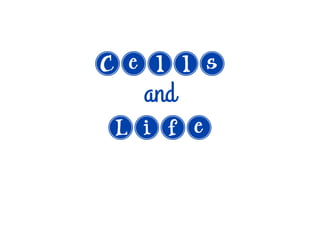
Cells and Life: Understanding Cells at the Molecular Level
- 2. Understanding Cells English scientist Robert Hooke first identified cells over 300 years ago while looking at cork under a microscope he built.
- 3. Understanding Cells Cork is actually made of water-resistant cells that separate the outer bark from the delicate interior bark.
- 4. Understanding Cells • Cork has a unique set of properties not found in any other naturally existing material. It is: • impermeable to gas and liquid • lightweight • rot resistant • fire resistant • termite resistant • soft • buoyant
- 5. Understanding Cells • In the cork Hooke saw small openings similar to a bee’s honeycomb. The openings reminded him of the small rooms, called cells, where monks lived. • Hooke named these small structures cells.
- 6. Cell Theory • Scientists made better microscopes than Hooke’s. • They looked for cells in places such as pond water and blood. • The newer microscopes made it possible for scientists to see different structures inside cells.
- 7. Cell Theory • A scientist named Matthias Schleiden looked at plant cells. • Another scientist, Theodore studied animal cells. Schwann, • Later, Rudolf Virchow said all cells come from cells that already exist. • The observations made by these scientists became known as the cell theory.
- 8. Cell Theory The Cell Theory states: 1. All living things are made of one or more cells. 2. The cell is the smallest unit of life. 3. All new cells come from pre-existing cells.
- 10. Basic Cell Substances • The cell theory raised more questions for scientists. Scientists began to look into what cells are made of. • Cells are made of smaller parts called macromolecules that form when many small molecules join together. • Macromolecules cannot function without one of the most important substances in cells - water.
- 11. Basic Cell Substances • The main ingredient in every cell is water. Making up more than 70 percent of a cell. • Water also surrounds cells, helping to insulate your body. This helps your body maintain a stable internal environment, or homeostasis. • Water also is useful because it can dissolve other substances, such as salt. • For substances to move into and out of a cell, they must be dissolved in a liquid.
- 12. Macromolecules in Cells • All cells contain other substances besides water that help cells do what they do. • There are four types of macromolecules in cells. They are nucleic acids, proteins, lipids, and carbohydrates. • Each type of macromolecule has its own function in a cell. These functions range from growth and communication to movement and storage.
- 13. Macromolecules in Cells Nucleic Acids • Both deoxyribonucleic acid (DNA) and ribonucleic acid (RNA) are nucleic acids. • Nucleic acids are important because they contain the genetic material of a cell. This information is passed from parents to offspring. • Nucleic acids are macromolecules formed when long chains of molecules called nucleotides join together.
- 14. Macromolecules in Cells Nucleic Acids DNA
- 15. Macromolecules in Cells Nucleic Acids DNA
- 16. Macromolecules in Cells Nucleic Acids DNA
- 17. Macromolecules in Cells Nucleic Acids DNA
- 18. Macromolecules in Cells Nucleic Acids DNA
- 19. Macromolecules in Cells Nucleic Acids DNA RNA
- 20. Macromolecules in Cells Nucleic Acids • DNA includes instructions for cell growth, for cell reproduction, and for cell processes that enable a cell to respond to its environment. • DNA is used to make RNA. RNA is used to make proteins. • The order of nucleotides in DNA and RNA is important. A change in the order of the nucleotides can change the information in a cell.
- 21. Macromolecules in Cells Proteins • The macromolecules necessary for almost everything cells do are proteins. • A protein is a macromolecule made of long chains of amino acid molecules. • RNA contains instructions for joining amino acids together to build the protein.
- 25. Macromolecules in Cells Proteins • A protein can contain 100 to 10,000’s amino acids. • Cells have hundreds of proteins. • Each protein has its own function. For example some: • help cells communicate with other cells • move substances around inside cells • help to break down nutrients in food • make up supporting structures (like hair, horns, and feathers)
- 26. Macromolecules in Cells Lipids • A lipid is a large macromolecule that does not dissolve in water. Because lipids do not dissolve in water, they protect cells. • Lipids also are a large part of the cell membrane. • Lipids store energy for cells and help with cell communication. • Cholesterol and vitamin A are lipids.
- 27. Macromolecules in Cells Lipids Cell Membrane
- 28. Macromolecules in Cells Carbohydrates • One sugar molecule, two sugar molecules, or a long chain of sugar molecules make up carbohydrates. • Carbohydrates store energy, provide structural support for cells, and help cells communicate.
- 29. Macromolecules in Cells Carbohydrates • Sugars and starches are carbohydrates that store energy. Fruits contain sugars. Bread and pasta are mostly starch. • The energy stored in sugars and starches can be released quickly through chemical reactions in cells. • Cellulose is a carbohydrate in the cell walls of plants.
- 31. Macromolecules in Cells Carbohydrate Starch chain of glucose
- 32. Macromolecules in Cells Carbohydrate Cellulose many chains of glucose bunched together